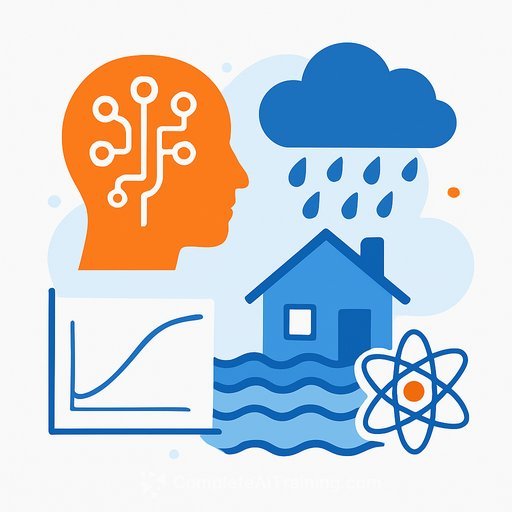Physics-guided AI forecasts river flow across the US to support extreme-weather planning
A team spanning Clemson University, Cardiff University, and IHE Delft has built physics-guided AI models that predict how rainfall translates into river flow across the United States. The approach blends watershed physics with deep learning to deliver accurate, probabilistic river-flow forecasts that decision-makers can trust.
The work, published in Water Resources Research, outperformed several traditional hydrologic methods and provides interpretable signals about why the model makes a given prediction. That combination-skill and clarity-positions the models for practical use in water management, climate risk assessment, and emergency response.
What's new
- Physics-guided learning: The models embed hydrologic constraints and watershed attributes, improving accuracy while keeping outputs explainable.
- Probabilistic forecasts: Instead of single values, the system estimates the likelihood of a range of river-flow events-useful for flood and drought planning.
- Stronger generalization: Trained on extensive observed and simulated rainfall-runoff data, including temporal patterns captured by transformer architectures.
How it works
The team integrated deep learning architectures (including transformers) with physical attributes from watersheds to model rainfall-runoff processes over time. Physical constraints guide the learning so the model stays consistent with hydrologic behavior, while the AI captures nonlinear relationships in the data.
The output is interpretable and probabilistic: researchers can see how inputs drive predicted flows and quantify uncertainty around high- and low-flow scenarios. This helps pinpoint model limitations and target improvements basin by basin.
Why it matters
- Actionable uncertainty: Probabilistic outputs support risk-aware operations, from reservoir releases to flood alerts.
- Operational trust: Built-in physics and interpretability make forecasts easier to validate and defend to stakeholders.
- Scalable coverage: A single framework trained across diverse US watersheds reduces the need for site-specific model builds.
- Diagnostic insight: Explanations reveal when and where the model struggles, guiding targeted data collection or retraining.
What the researchers say
"This work was prompted by the need for more accurate and understandable tools to predict how rainfall translates into river flow."
"Traditional hydrologic models often struggle with complex watershed behaviours and complex river flow simulation.
By embedding physical constraints into modern AI architectures, we developed two probabilistic, physics-guided models that outperform existing methods and offer clear insights into how river flow responds to rainfall."
"By embedding physical attributes from watershed, our models achieved both high accuracy and interpretability. This enables scientists, water managers, and other stakeholders to better understand hydrological processes, identify potential vulnerabilities, and assess uncertainties in river flow forecasts."
"Our goal was to build river-flow prediction tools that are more accurate and easier to trust. By combining physics with AI, we can give scientists and water managers clearer insights into when and why rivers respond the way they do, which is critical for preparing communities for floods, droughts, and weather extremes."
Practical takeaways for science and research teams
- Data strategy: Pair observed streamflow with gridded precipitation and watershed attributes; include simulated rainfall-runoff where observations are sparse.
- Model diagnostics: Use the model's explanations to test hypotheses about storage, infiltration, and routing in specific basins.
- Validation: Evaluate across flow regimes (low, median, high) and seasons; emphasize extremes where decisions are most sensitive.
- Uncertainty for decisions: Translate probabilistic outputs into thresholds for warnings, reservoir rules, and drought triggers.
- Interoperability: Compare or integrate with operational systems like the NOAA National Water Model to stress-test in real workflows.
What's next
The group plans to extend the models with soil moisture, land-use change, and climate projections to improve performance under nonstationary conditions. They will also partner with water managers, emergency responders, and policymakers to deploy the tools in real decision environments and refine interpretability based on user feedback.
Where to learn more
- Peer-reviewed paper: Water Resources Research
- Upskilling on AI for data analysis: Certification pathway
Source: Cardiff University
Your membership also unlocks:






